Chaojing Duan
Signal, Image, or Symbolic: Exploring the Best Input Representation for Electrocardiogram-Language Models Through a Unified Framework
May 24, 2025Abstract:Recent advances have increasingly applied large language models (LLMs) to electrocardiogram (ECG) interpretation, giving rise to Electrocardiogram-Language Models (ELMs). Conditioned on an ECG and a textual query, an ELM autoregressively generates a free-form textual response. Unlike traditional classification-based systems, ELMs emulate expert cardiac electrophysiologists by issuing diagnoses, analyzing waveform morphology, identifying contributing factors, and proposing patient-specific action plans. To realize this potential, researchers are curating instruction-tuning datasets that pair ECGs with textual dialogues and are training ELMs on these resources. Yet before scaling ELMs further, there is a fundamental question yet to be explored: What is the most effective ECG input representation? In recent works, three candidate representations have emerged-raw time-series signals, rendered images, and discretized symbolic sequences. We present the first comprehensive benchmark of these modalities across 6 public datasets and 5 evaluation metrics. We find symbolic representations achieve the greatest number of statistically significant wins over both signal and image inputs. We further ablate the LLM backbone, ECG duration, and token budget, and we evaluate robustness to signal perturbations. We hope that our findings offer clear guidance for selecting input representations when developing the next generation of ELMs.
ECG-Byte: A Tokenizer for End-to-End Generative Electrocardiogram Language Modeling
Dec 18, 2024



Abstract:Large Language Models (LLMs) have shown remarkable adaptability across domains beyond text, specifically electrocardiograms (ECGs). More specifically, there is a growing body of work exploring the task of generating text from a multi-channeled ECG and corresponding textual prompt. Current approaches typically involve pretraining an ECG-specific encoder with a self-supervised learning (SSL) objective and using the features output by the pretrained encoder to finetune a LLM for natural language generation (NLG). However, these methods are limited by 1) inefficiency from two-stage training and 2) interpretability challenges with encoder-generated features. To address these limitations, we introduce ECG-Byte, an adapted byte pair encoding (BPE) tokenizer pipeline for autoregressive language modeling of ECGs. This approach compresses and encodes ECG signals into tokens, enabling end-to-end LLM training by combining ECG and text tokens directly, while being much more interpretable since the ECG tokens can be directly mapped back to the original signal. Using ECG-Byte, we achieve competitive performance in NLG tasks in only half the time and ~48% of the data required by two-stage approaches.
Interpretation of Intracardiac Electrograms Through Textual Representations
Feb 02, 2024



Abstract:Understanding the irregular electrical activity of atrial fibrillation (AFib) has been a key challenge in electrocardiography. For serious cases of AFib, catheter ablations are performed to collect intracardiac electrograms (EGMs). EGMs offer intricately detailed and localized electrical activity of the heart and are an ideal modality for interpretable cardiac studies. Recent advancements in artificial intelligence (AI) has allowed some works to utilize deep learning frameworks to interpret EGMs during AFib. Additionally, language models (LMs) have shown exceptional performance in being able to generalize to unseen domains, especially in healthcare. In this study, we are the first to leverage pretrained LMs for finetuning of EGM interpolation and AFib classification via masked language modeling. We formulate the EGM as a textual sequence and present competitive performances on AFib classification compared against other representations. Lastly, we provide a comprehensive interpretability study to provide a multi-perspective intuition of the model's behavior, which could greatly benefit the clinical use.
Converting ECG Signals to Images for Efficient Image-text Retrieval via Encoding
Apr 13, 2023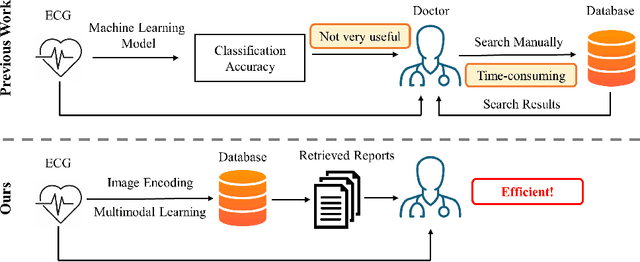
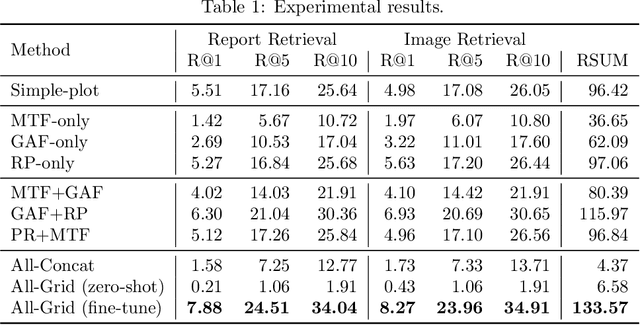


Abstract:Automated interpretation of electrocardiograms (ECG) has garnered significant attention with the advancements in machine learning methodologies. Despite the growing interest in automated ECG interpretation using machine learning, most current studies focus solely on classification or regression tasks and overlook a crucial aspect of clinical cardio-disease diagnosis: the diagnostic report generated by experienced human clinicians. In this paper, we introduce a novel approach to ECG interpretation, leveraging recent breakthroughs in Large Language Models (LLMs) and Vision-Transformer (ViT) models. Rather than treating ECG diagnosis as a classification or regression task, we propose an alternative method of automatically identifying the most similar clinical cases based on the input ECG data. Also, since interpreting ECG as images are more affordable and accessible, we process ECG as encoded images and adopt a vision-language learning paradigm to jointly learn vision-language alignment between encoded ECG images and ECG diagnosis reports. Encoding ECG into images can result in an efficient ECG retrieval system, which will be highly practical and useful in clinical applications. More importantly, our findings could serve as a crucial resource for providing diagnostic services in regions where only paper-printed ECG images are accessible due to past underdevelopment.
Deep Unsupervised Learning of 3D Point Clouds via Graph Topology Inference and Filtering
May 11, 2019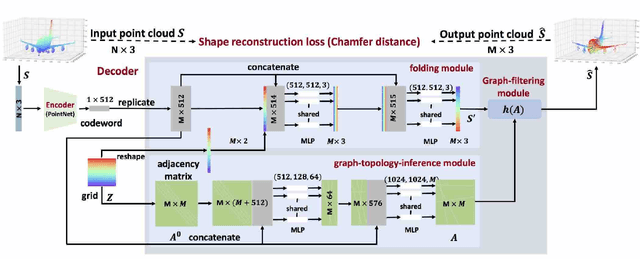
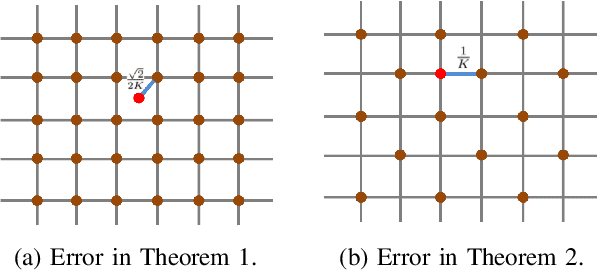
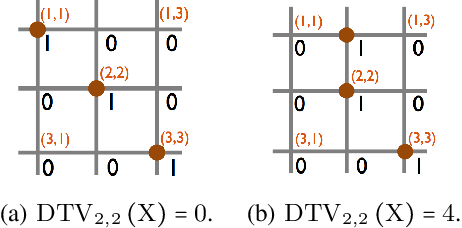
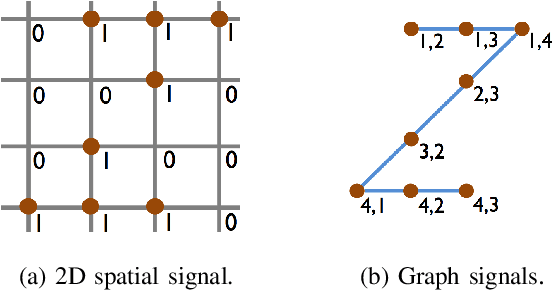
Abstract:We propose a deep autoencoder with graph topology inference and filtering to achieve compact representations of unorganized 3D point clouds in an unsupervised manner. The encoder of the proposed networks adopts similar architectures as in PointNet, which is a well-acknowledged method for supervised learning of 3D point clouds. The decoder of the proposed networks involves three novel modules: the folding module, the graph-topology-inference module, and the graph-filtering module. The folding module folds a canonical 2D lattice to the underlying surface of a 3D point cloud, achieving coarse reconstruction; the graph-topology-inference module learns a graph topology to represent pairwise relationships between 3D points; and the graph-filtering module designs graph filters based on the learnt graph topology to obtain the refined reconstruction. We further provide theoretical analyses of the proposed architecture. We provide an upper bound for the reconstruction loss and further show the superiority of graph smoothness over spatial smoothness as a prior to model 3D point clouds. In the experiments, we validate the proposed networks in three tasks, including reconstruction, visualization, and classification. The experimental results show that (1) the proposed networks outperform the state-of-the-art methods in various tasks, including reconstruction and transfer classification; (2) a graph topology can be inferred as auxiliary information without specific supervision on graph topology inference; and (3) graph filtering refines the reconstruction, leading to better performances.
3D Point Cloud Denoising via Deep Neural Network based Local Surface Estimation
Apr 09, 2019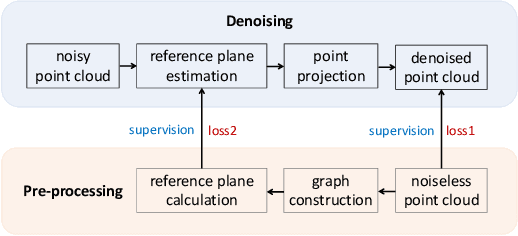

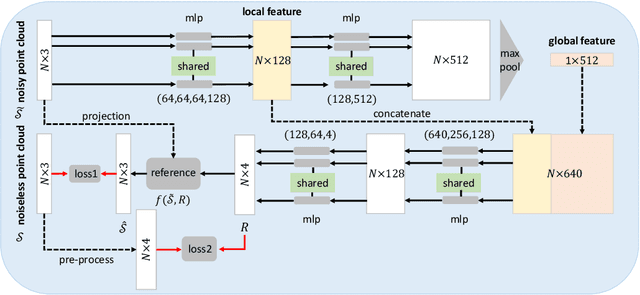
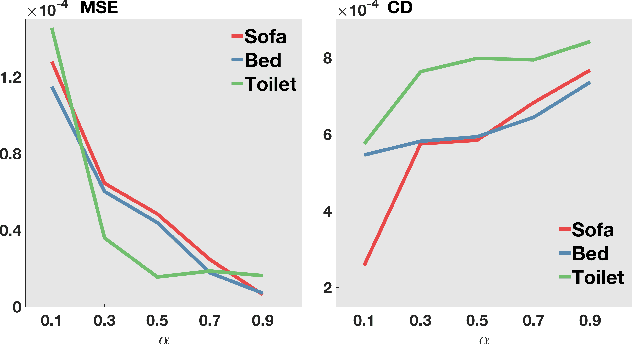
Abstract:We present a neural-network-based architecture for 3D point cloud denoising called neural projection denoising (NPD). In our previous work, we proposed a two-stage denoising algorithm, which first estimates reference planes and follows by projecting noisy points to estimated reference planes. Since the estimated reference planes are inevitably noisy, multi-projection is applied to stabilize the denoising performance. NPD algorithm uses a neural network to estimate reference planes for points in noisy point clouds. With more accurate estimations of reference planes, we are able to achieve better denoising performances with only one-time projection. To the best of our knowledge, NPD is the first work to denoise 3D point clouds with deep learning techniques. To conduct the experiments, we sample 40000 point clouds from the 3D data in ShapeNet to train a network and sample 350 point clouds from the 3D data in ModelNet10 to test. Experimental results show that our algorithm can estimate normal vectors of points in noisy point clouds. Comparing to five competitive methods, the proposed algorithm achieves better denoising performance and produces much smaller variances.
 Add to Chrome
Add to Chrome Add to Firefox
Add to Firefox Add to Edge
Add to Edge